Dome of the Dhyanalinga
Meditation Shrine
- Stability Notions
- Stability Calculations
- Arches Vaults & Domes (AVD) Construction
- Office of the Earth Institute
- Egyptian Vault
- Catenary Vault
- Deepanam AVD
- Semicircular Vault
- Equilateral Pointed Vault
- Bucket Pointed Vault
- Dhyanalinga dome
- Segmental Groined Dome
- Gayatri dome
- Equilateral groined vault
- AVD Video clips



Sadhguru Jaggi Vasudev, from the Isha Foundation, asked the Auroville Earth Institute to build this dome as fast as possible, so as to shelter the Dhyanalinga of 14 feet high which was inside. The Dhyanalinga is a special one: It is a mercury based linga and the dome was essential to lock the energy of the Dhyanalinga.
The Auroville Earth Institute designed the dome, studied its stability, trained local and unskilled labour, and supervised the works with its team.
No deadline had been given by Sadhguru, but it was requested to build the dome as fast as possible, so that Sadhguru could do his yogic work. Therefore the Auroville Earth Institute organised the site in such a way so that this dome of 22.16 m diameter and about 570 tons was built in 9 weeks without support and with more than 200 workers.
The Dhyanalinga is a Multi-religious Meditation Shrine created exclusively for the purpose of meditation. This dome of the Dhyanalinga Shrine was built for the ISHA Foundation, at the Foothills of Velliangiri Mountains near Coimbatore, Tamil Nadu, South India.
This dome of 22.16 m diameter has designed by the Auroville Earth Institute. It has been built free spanning in 9 weeks with a team of the Auroville Earth Institute and mostly unskilled labour.
The work on the dome started the 21st November 1998 with the construction of the entrance vault, built with granite stones and on a centering done with laterite blocks. The dome was completed 9 weeks later, the 31st January 1999.
THE DOME
A tight schedule was set from the beginning by the Guru, Sadhguru Jaggi Vasudev. The dome had to be completed before a certain deadline related with his yogic practices and planetary aspects. Therefore the use of CSEB had been eliminated from the beginning. The time requested for the production, curing and drying of the blocks (3 – 4 months compulsory for arches, vaults and domes) would have been too long! Thus the choice went for fired bricks, which were laid with a stabilised earth mortar. The foundations and walls were built in random rubble masonry with granite stones in lime mortar.
Around 214,000 fired bricks were laid and the construction site had a working force of more than 220 workers (110 workers at the most on the scaffoldings, including 25 masons). The large amount of fired bricks required could not be supplied by the same brick factory. Therefore the fired bricks came from about 20 different kilns. As a result, they had different sizes and most of the time they had odd shapes (belly, cracks and other irregularities). Therefore, nearly 200,000 bricks had to be checked one by one. It became a pain to use such bricks when it would have been so easy to use the accurate CSEB produced by the Auram press 3000. In most of cultures hell is related with fire, and indeed it was a hell to build with these fired bricks!
No reinforce concrete had been used in any part of the building: neither for the foundations, plinth nor tie for the dome. Sadhguru Jaggi wanted the dome to last 1,000 years and reinforced concrete has not yet proved to be able to last so long. Therefore the dome stability has been studied in order to have only compression forces.
The dome presents these features:
• Section: segmental ellipse of 22.16 m diameter and 7,90 m rise.
• Thickness: 4 courses from the springer to the apex: 53 cm, 42 cm, 36.5 cm and 21 cm at the top.
• Weight: around 570 tons (brick dome = ± 420 tons + granite stone to load the haunches = ± 150 tons).
DOME STABILITY STUDY
At that time, to our knowledge, no comprehensive and sure method exited to study the stability of a masonry dome. First the method of Gernot Minke, called “Structurally optimised dome” was followed. But in fact this method was not satisfactory to optimise the line of thrust as it defines only the resultant angle of the trust: Gernot Minke does not want to use concrete ring beams and therefore his method does not define the optimised line of thrust in the dome because it does not take in account the concentric forces, which are acting in a dome and allow building it without support.
Finally the dome was studied like a vault, which is more sensitive to a wrong shape than a dome: if a vault is stable, a dome will be stable…when the opposite is not necessarily true. As no reinforced concrete was used for any tie, it was compulsory to get the resultant of the trust within the middle third of the ring wall and the foundations. To do so, granite stones were used to load the haunch of the dome.
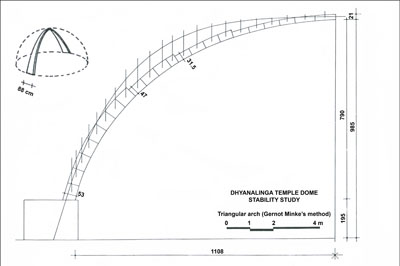


With the dome rising, the mortar specification needed regularly to be adapted: adding more soil, in 3 steps, so as to have the ideal adhesion according to the angle of the layers. The different mortars were over stabilised so as to get a fast setting and strength: 13 to 13.37% of cement and 19% of lime.
Single resonator absorbers (Helmholtz resonators) were installed in three layers, so as to absorb 12 frequencies between 120 Hz and 1.50 kHz. The result was a dome without echo but still with a certain reverberation, which was normal because of its volume. This gave also a certain sound quality.
CONSTRUCTION SEQUENCES OF THE DOME





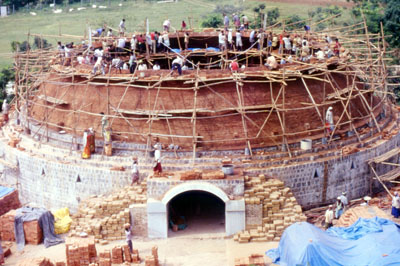



CONSTRUCTION DETAILS OF THE DOME
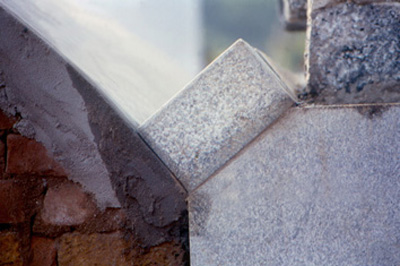
















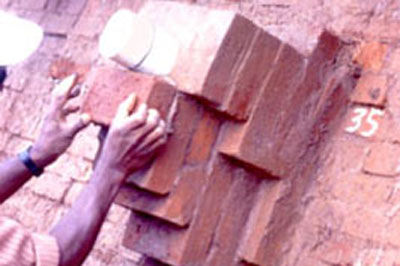



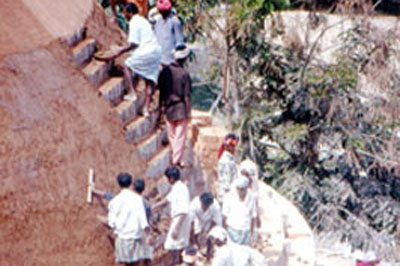

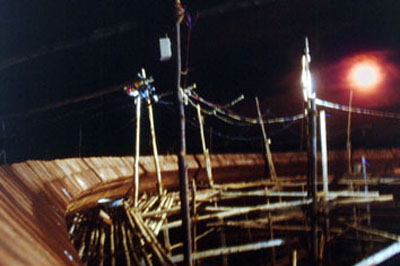







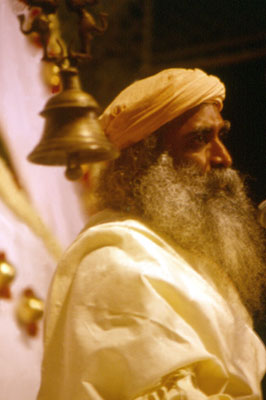

Contact US
- Address:Auroville Earth Institute, Auroshilpam, Auroville 605 101 - T.N. India
- Phone:+91 (0) 413 - 262 3330 / 262 3064
- Email:info@earth-auroville.comOpens in your application

